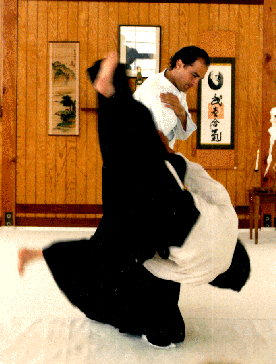Miscellaneous Questions About Aikido
How do I find an Aikido dojo near me?
There are several options available to you (not listed in any particular order):
- The Aikido Dojo Guide
- Aikido search engine You should definitely check these two before even dreaming of posting a request to the Aikido-L list. ;-)
- Check the Yellow Pages under Martial Arts or Karate (I know, I know!)
- Ask fellow local martial artists
- Ask at martial arts stores
- Ask at commercial dojos (it doesn't have to teach the art you wish to study)
- Ask at general fitness places, especially the YMCA.
- Ask at any universities or colleges about clubs or classes
How do I choose the best dojo?
The choice of a dojo is a very personal one. Everyone has their own path of learning, their own goals and expectations. The "best" dojo for one person is likely not the same as the "best" dojo for the next person.
If one is lucky enough to live in an area that has several, visit all of them. Get permission to watch some classes and observe how classes are taught, and how the students and instrutors relate to each other. Is there a sense of mutual respect? Is there tension and fear? Does the atmosphere seem to promote growth? Most importantly, are you comfortable there? Try to visit while the chief instructor is teaching, but also try to get a feel for other people who may be teaching. See if the teacher appears to respect the students, and that they respect him/her.
Talk to various students and ask their opinions meanwhile noting their demeanor. A good sign is if either before or after a class which you are observing, a senior student or instructor comes over and talks to you. If you are ignored, it may not be the kind of dojo you are looking for.
Remember, this is where you hope to be spending a fair amount of time, and you want it to be a positive and rewarding experience. One final question, also very important, is simply "Do I like this dojo and these people?"
Beware of any dojo that tries to pressure you into a quick decision or is averse to letting you watch a few classes.
While the chief instructor's rank may be somewhat important, be wary of inflated qualifications. Although an affiliation with a national or international organization is no guarantee of quality (and some teachers, such as Gaku Homma Sensei are not affiliated at all), it can be a useful indication. Promotions given by non-affiliated dojos are not likely to be recognized anywhere else, and this may well be a consideration.
Once a dojo has been selected, sign up and attend a beginner's session and complete it, attending all of the classes. At the end of this introductory period you should have a good sense of whether it is the right place for you.
There is an informative posting which appears periodically in the rec.martial-arts newsgroup called The Newbie Guide to Martial Arts Training. It is written by Jeff Pipkins and is well worth a look.
Is Steven Seagal really an Aikidoka? What is his rank?

Steven Seagal
Steven Seagal really is an Aikido instructor (or was, until his movie career got in the way). He has a rank of seventh dan (Aikikai) and has run his own dojo in both Japan and the United States. Most of what you see in the movies, however, is not Aikido as it is practised in the dojo. Some argue that it is not Aikido at all.
His Aikido is for real. Here's what Wendy Palmer had to say in "Aikido in America":
He has great throws. Very energetic, very fast, very powerful. He would throw me -- bam! -- I'd hit the mat; the spit would fly out of my mouth, that kind of thing, just really powerful. [...] He had very good Aikido. He really did. He threw me very energetically. At that time he was not particularly muscled. He was strong, aiki-strong, but he didn't have a kind of gym-muscle body at all. This throws were very fast, very energetic. You never knew what happened. He could do that art.
Does Aikido have punches or kicks? Or defences against these?
There are strikes in Aikido (see Atemi), but they are never more than supplementary to a particular technique: no technique in Aikido ever has striking one's opponent as its aim. That said, there are numerous counters to striking attacks (punches, thrusts, roundhouses, etc.) delivered by others. Kicks are not often used in Aikido, and although specific responses exist, they are not often practiced. Most of the strikes and kicks have been toned down, but they are still there. Aikido, while it can be studied simply as an array of effective techniques, should not be thought of as limited in this way. Even if you've never studied a specific response to being attacked by a three-legged, five-armed alien, Aikido should enable you to defend yourself even in novel situations.
What is the unbendable arm and what is its value?
Variously described as an impressive display of the power of ki, all the way down to a simple parlor trick, the unbendable arm is a demonstration wherein the demonstrator extends his arm and challenges others to bend it. Simple. Ostensibly by "extending ki" through his arm, the demonstrator can make it impossible for anyone to bend it. Its value depends on the viewer.